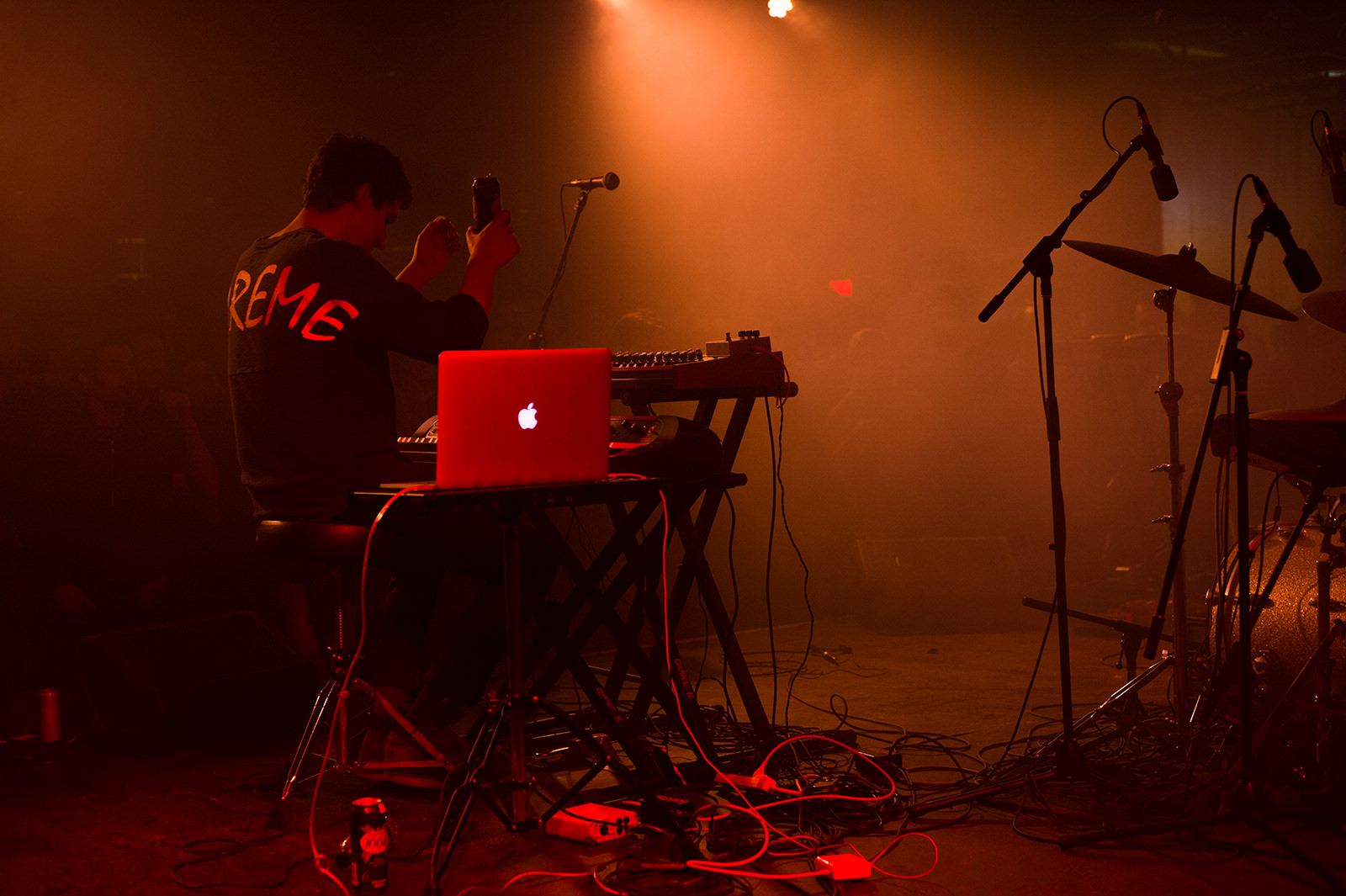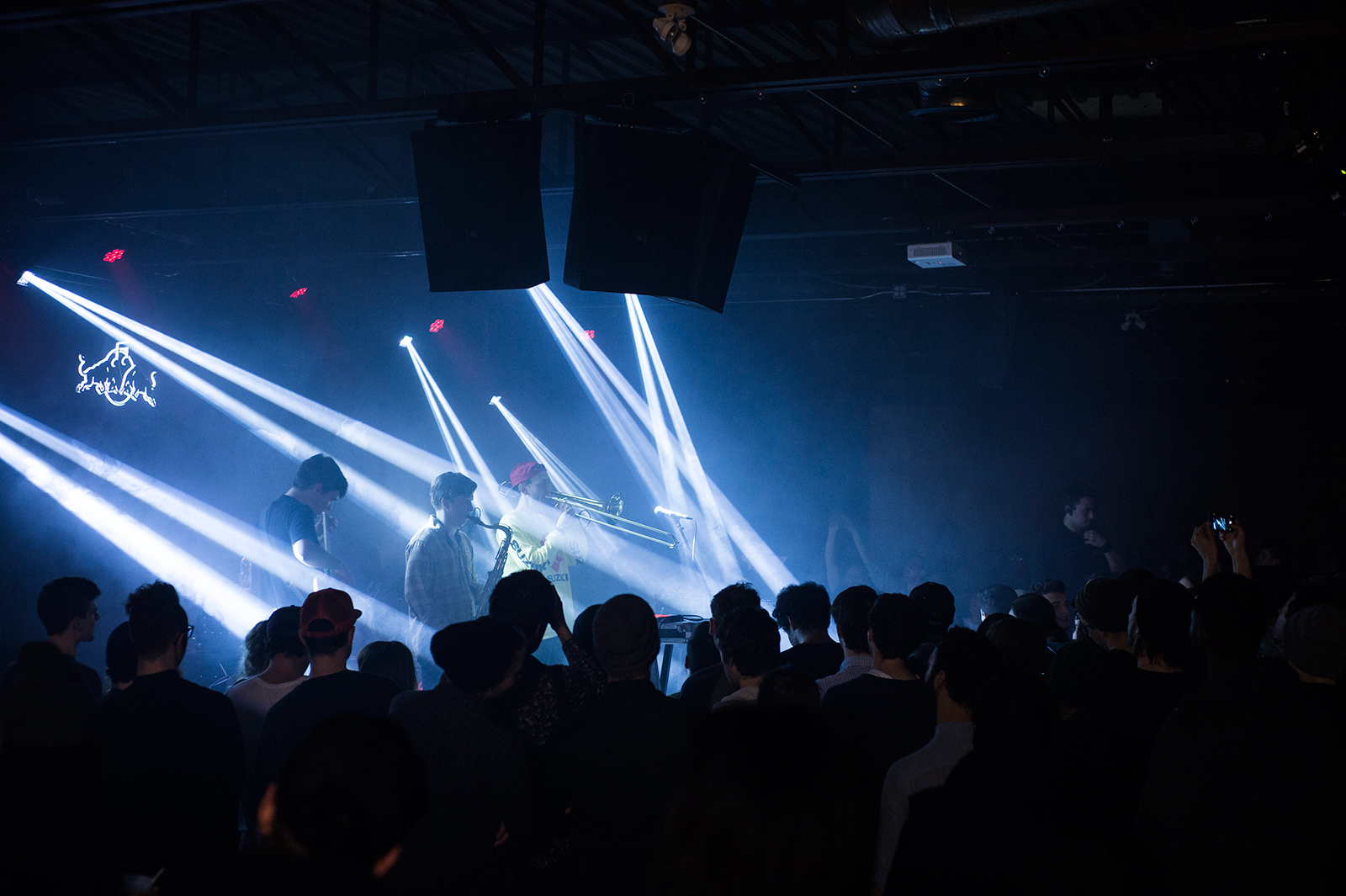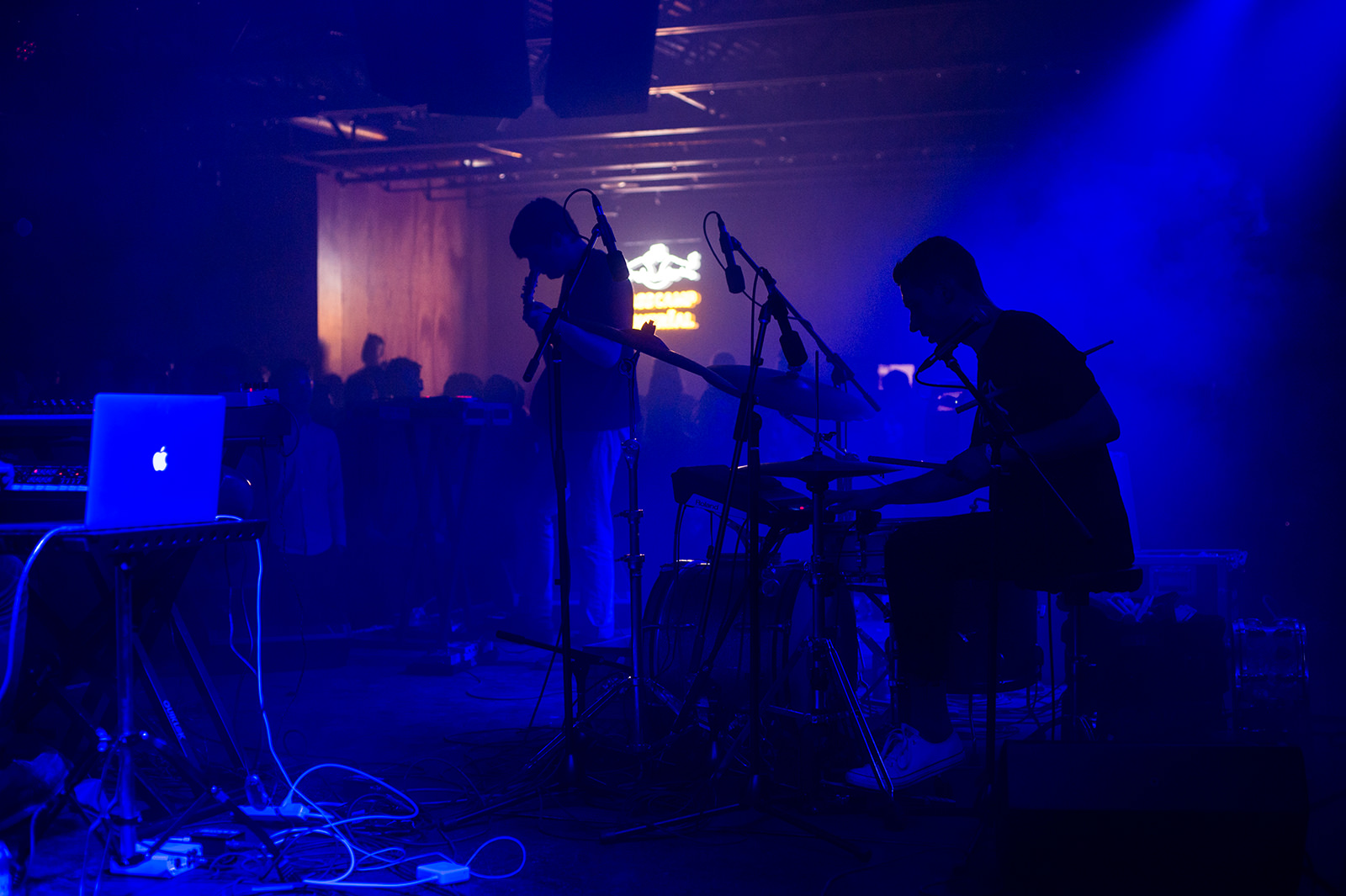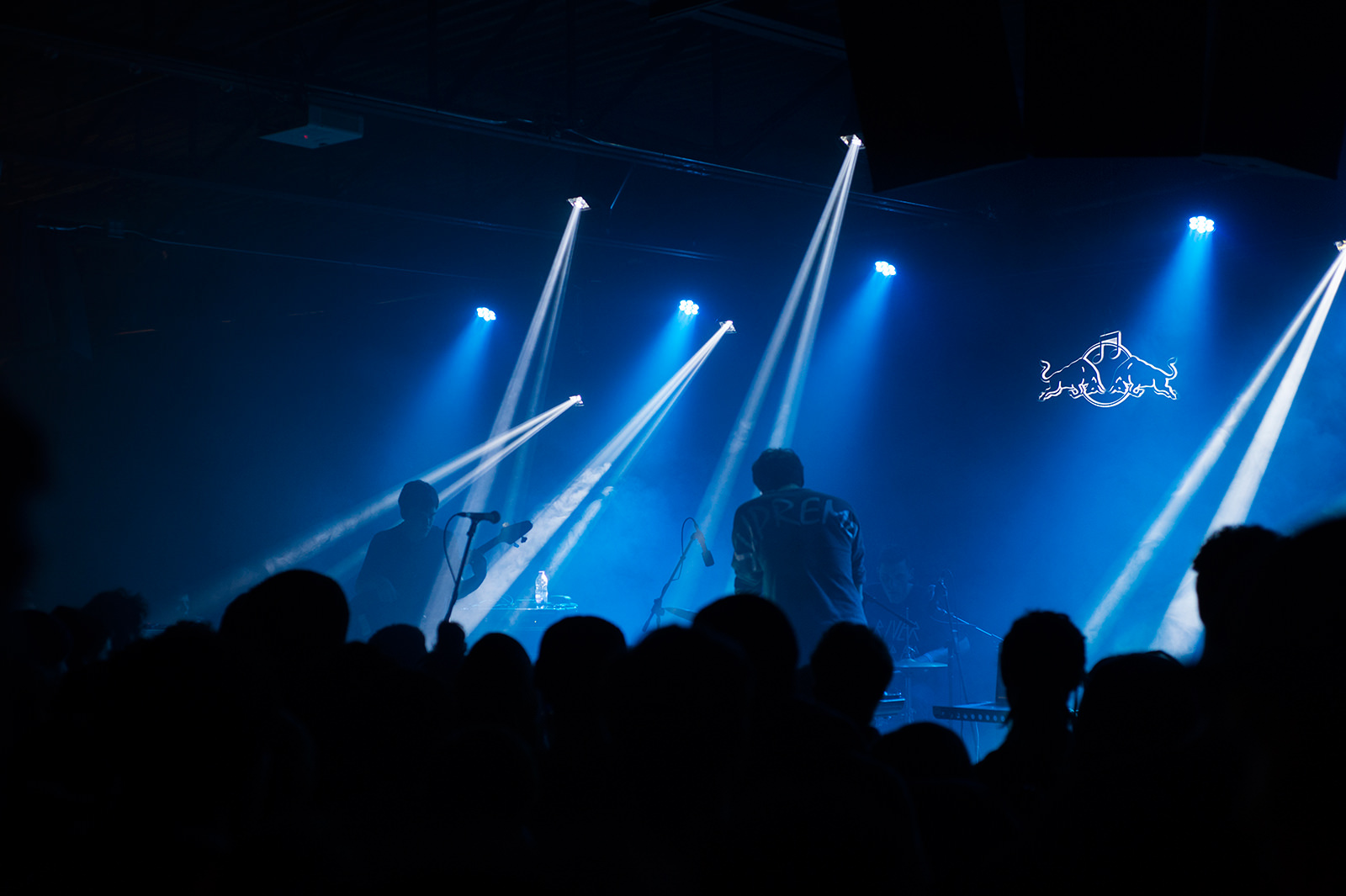
Facing a Blank Slate.
In an age where electronic dance inoculates the airwaves, a classically trained jazz ensemble proves to be the ideal antidote for the musical monotony.
The owners of Montreal’s newly minted Fairmount Theatre feared they would not be able to open their doors that night. The smell of fresh paint was, for better or worse, going to be a fixture of the ambiance. The big furniture had been hauled away. People sat awkwardly on the raised carpeted floor that had belonged, up until a few nights before, to a cabaret venue. DJ Simahlak, a pillar of Montreal’s rap scene, set the tone for the night by clashing big band standards with a mix of both deep house and A$AP Rocky. Scant fixtures of the past remained as a new chapter of the venue’s history was ready to be written.
In the dark, the outline of two bovines locking horns boldly stood out in neon. They served as a brazen reminder of why we were all there.
The occasion: the closing night of Red Bull Music Academy’s ambitious Bass Camp program.
The band tasked to bring a close to an epic weekend: jazz trio BadBadNotGood.
“Jazz trio” – two words that almost never describe the apex of any cutting edge music festival. Yet there we were. Since the 1920s, nothing was as definitively counter-culture as the free-flowing non-structure of jazz. In the monotony of today’s droning machine beats, nothing could break the mold better than live musicians playing in non-quantized abandon.
But in a double-twist, BadBadNotGood could never really be that lounge trio playing Benny Goodman in a hotel lobby, either. The standards they perform renditions of are not Coltrane, Basie or Getz. Think Kanye, Based God and Nas. Their crowds mosh and act like they’re at a frat party.
“We’re still just a product of all these artists and we continue to be that,” explains pianist Matt Tavares. “As we find new inspiration and sounds from all over the world, that’s the progression of our brains.”
Tavares, bassist Chester Hansen and drummer Alex Sowinski forged their bond as freshmen in the jazz program of Toronto’s Humber College. Their common affinity for new rap music gave them a fresh angle from which to approach their classical training. Consider it reverse sampling: they would employ the riffs and melodies of their favorite rap songs as a launching pad for improvisation and then circle back to those melodies to tie it all in.
Tavares said the band relished the challenge. “It’s less easy to take something that’s another song and make it sound how you want it to sound. It’s super funny learning from stuff like that.”
Renditions of hood stars like Gucci Mane made them musical outliers and an attraction for others of the same ilk. On a tour stop, Odd Future’s Tyler, The Creator made it a point to visit Chester’s home to record a video with the trio. Chester recognized the message in their medium. “These songs can still transfer into the contemporary era of production and doing things. People aren’t sampling as many jazz records nowadays. They want a bigger sound.”
With their young, impressionable minds – each member is still in their early 20s – BBNG turned to producer Frank Dukes for mentorship. For the uninitiated, Dukes provided the griminess for Drake’s 2014 anthem “0 to 100” and has done soundtracks for hip hop mainstays like 50 Cent, Kool G Rap and Danny Brown. Recognizing that they had the chops, Dukes opened his doors and created a free-flowing exchange of knowledge with the boys.
The band’s spirits perk up when they describe him. Matt explains, “Being together, we’ve taught each other everything we were the best at. We teach him something, and he teaches us something. It’s a two-way street.” Be it engineering techniques or old keyboards to use, the relationship has always been mutually beneficial. “He has amazing taste,” Alex adds. “He’s good at facilitating the things he likes, and making them happen.”
One of the biggest things Dukes arranged for the group was a collaboration with one of hip hop’s most distinct personas: Ghostface Killah. The thinking was that BBNG’s ability to keep a rap loop open-ended could mesh well with Ghost’s old uptown tavern ramblings. Through Dukes’ connections, a pitch to Ghostface was made, and an album three years in the making was spawned: Sour Soul.
Besides the Tyler videos, BadBadNotGood had rarely worked with rappers, let alone created a full-length album with a hip hop icon. As a band, they acknowledged the need to reel in their solos to introduce vocal elements. At the same time, they didn’t want to show up only to fade into the background. They were a living, breathing entity that still needed to flex, so compromise was important.
“You have to keep in mind leaving a space to do their thing and incorporate their styles,” Chester says. “We keep the idea and feeling as tight as possible and leave it open for new ideas to be accepted.” “Tone’s Rap” exemplifies both parties co-existing: Ghost laments the lint on his robe that is hindering his pimp game with a slurred flow. BBNG slinks through the track like molasses, slowly colluding to a crescendo after two minutes. Neither side backs down, yet neither party is overwhelmed.
Four albums in and you forget that they are still fresh dropouts from college. With such a range of sounds already conquered, it’s easy to imagine BBNG as weathered session musicians with leathery faces and worn trench coats. Instead, they are three young men with smiles brimming from ear to ear, boasting about having already found the key to life. “It’s about connecting with people and creating shit,” Kowinski declares with certainty. “It’s about exploring and figuring it out.”

After their show at the Fairmount, the crowds leave satiated. The theatre is no longer home to the same old song and dance of its cabaret history. An air of newness and excitement that only youthful thinking can provide occupy this space now.
Backstage, BadbadNotGood enjoy celebratory beers with their inner circle. They enjoy each other’s company and the unique position the band is in. Matt Tavares puts the important things in perspective. “I’m happy to just be with some amazing friends. We’re gonna continue this for as long as we can.” With a firm grasp on their past and facing a clean slate in their future, BadBadNotGood’s new chapter is poised to be written.
BadBadNotGood’s latest solo album, III, is available now.
BadBadNotGood’s album with Ghostface Killah, Sour Soul, is also available now.
The owners of Montreal's newly minted Fairmount Theatre feared they would not be able to open their doors that night. The smell of fresh paint was, for better or worse, going to be a fixture of the ambiance. The big furniture had been hauled away. People sat awkwardly on the raised carpeted floor that had belonged, up until a few nights before, to a cabaret venue. DJ Simahlak, a pillar of Montreal’s rap scene, set the tone for the night by clashing big band standards with a mix of both deep house and A$AP Rocky. Scant fixtures of the past remained as a new chapter of the venue's history was ready to be written.
In the dark, the outline of two bovines locking horns boldly stood out in neon. They served as a brazen reminder of why we were all there.
The occasion: the closing night of Red Bull Music Academy's ambitious Bass Camp program.
The band tasked to bring a close to an epic weekend: jazz trio BadBadNotGood.
“Jazz trio” - two words that almost never describe the apex of any cutting edge music festival. Yet there we were. Since the 1920s, nothing was as definitively counter-culture as the free-flowing non-structure of jazz. In the monotony of today's droning machine beats, nothing could break the mold better than live musicians playing in non-quantized abandon.
But in a double-twist, BadBadNotGood could never really be that lounge trio playing Benny Goodman in a hotel lobby, either. The standards they perform renditions of are not Coltrane, Basie or Getz. Think Kanye, Based God and Nas. Their crowds mosh and act like they’re at a frat party.
"We're still just a product of all these artists and we continue to be that," explains pianist Matt Tavares. "As we find new inspiration and sounds from all over the world, that's the progression of our brains."
Tavares, bassist Chester Hansen and drummer Alex Sowinski forged their bond as freshmen in the jazz program of Toronto’s Humber College. Their common affinity for new rap music gave them a fresh angle from which to approach their classical training. Consider it reverse sampling: they would employ the riffs and melodies of their favorite rap songs as a launching pad for improvisation and then circle back to those melodies to tie it all in.
Tavares said the band relished the challenge. "It's less easy to take something that's another song and make it sound how you want it to sound. It's super funny learning from stuff like that."
Photographer - Photo: Paul Swanson
People aren't sampling as many jazz records nowadays. They want a bigger sound."
Renditions of hood stars like Gucci Mane made them musical outliers and an attraction for others of the same ilk. On a tour stop, Odd Future’s Tyler, The Creator made it a point to visit Chester's home to record a video with the trio. Chester recognized the message in their medium. "These songs can still transfer into the contemporary era of production and doing things. People aren't sampling as many jazz records nowadays. They want a bigger sound."
With their young, impressionable minds - each member is still in their early 20s - BBNG turned to producer Frank Dukes for mentorship. For the uninitiated, Dukes provided the griminess for Drake's 2014 anthem "0 to 100" and has done soundtracks for hip hop mainstays like 50 Cent, Kool G Rap and Danny Brown. Recognizing that they had the chops, Dukes opened his doors and created a free-flowing exchange of knowledge with the boys.
The band’s spirits perk up when they describe him. Matt explains, "Being together, we've taught each other everything we were the best at. We teach him something, and he teaches us something. It's a two-way street." Be it engineering techniques or old keyboards to use, the relationship has always been mutually beneficial. “He has amazing taste,” Alex adds. “He's good at facilitating the things he likes, and making them happen.”
One of the biggest things Dukes arranged for the group was a collaboration with one of hip hop’s most distinct personas: Ghostface Killah. The thinking was that BBNG’s ability to keep a rap loop open-ended could mesh well with Ghost’s old uptown tavern ramblings. Through Dukes’ connections, a pitch to Ghostface was made, and an album three years in the making was spawned: Sour Soul.
Besides the Tyler videos, BadBadNotGood had rarely worked with rappers, let alone created a full-length album with a hip hop icon. As a band, they acknowledged the need to reel in their solos to introduce vocal elements. At the same time, they didn’t want to show up only to fade into the background. They were a living, breathing entity that still needed to flex, so compromise was important.
“You have to keep in mind leaving a space to do their thing and incorporate their styles,” Chester says. “We keep the idea and feeling as tight as possible and leave it open for new ideas to be accepted.” “Tone’s Rap” exemplifies both parties co-existing: Ghost laments the lint on his robe that is hindering his pimp game with a slurred flow. BBNG slinks through the track like molasses, slowly colluding to a crescendo after two minutes. Neither side backs down, yet neither party is overwhelmed.
Four albums in and you forget that they are still fresh dropouts from college. With such a range of sounds already conquered, it’s easy to imagine BBNG as weathered session musicians with leathery faces and worn trench coats. Instead, they are three young men with smiles brimming from ear to ear, boasting about having already found the key to life. “It’s about connecting with people and creating shit,” Kowinski declares with certainty. “It’s about exploring and figuring it out.”

After their show at the Fairmount, the crowds leave satiated. The theatre is no longer home to the same old song and dance of its cabaret history. An air of newness and excitement that only youthful thinking can provide occupy this space now.
Backstage, BadbadNotGood enjoy celebratory beers with their inner circle. They enjoy each other’s company and the unique position the band is in. Matt Tavares puts the important things in perspective. “I'm happy to just be with some amazing friends. We're gonna continue this for as long as we can.” With a firm grasp on their past and facing a clean slate in their future, BadBadNotGood’s new chapter is poised to be written.
BadBadNotGood’s latest solo album, III, is available now.
BadBadNotGood’s album with Ghostface Killah, Sour Soul, is also available now.


